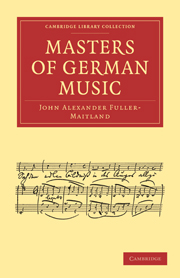Book contents
- Frontmatter
- PREFACE
- Contents
- LIST OF ILLUSTRATIONS
- JOHANNES BRAHMS
- MAX BRUCH
- KARL GOLDMARK
- JOSEF RHEINBERGER
- THEODOR KIRCHNER—CARL REINECKE—WOLDEMAR BARGIEL
- JOSEPH JOACHIM—CLARA SCHUMANN
- HEINRICH VON HERZOGENBERG—HEINRICH HOFMANN—ANTON BRUCKNER—FELIX DRAESEKE
- JEAN LOUIS NICODÉ—RICHARD STRAUSS—HANS SOMMER—CYRILL KISTLER
- Plate section
JOSEF RHEINBERGER
Published online by Cambridge University Press: 05 October 2010
- Frontmatter
- PREFACE
- Contents
- LIST OF ILLUSTRATIONS
- JOHANNES BRAHMS
- MAX BRUCH
- KARL GOLDMARK
- JOSEF RHEINBERGER
- THEODOR KIRCHNER—CARL REINECKE—WOLDEMAR BARGIEL
- JOSEPH JOACHIM—CLARA SCHUMANN
- HEINRICH VON HERZOGENBERG—HEINRICH HOFMANN—ANTON BRUCKNER—FELIX DRAESEKE
- JEAN LOUIS NICODÉ—RICHARD STRAUSS—HANS SOMMER—CYRILL KISTLER
- Plate section
Summary
Of the many classes of musical material, none was more prolific of influence upon German composers of the earlier generations than the organ. The art of organ-composition and performance (the two were so constantly joined in one individual that they are fitly spoken of together), starting in Italy and the Netherlands almost simultaneously, found in Germany a soil prepared for their growth by the Lutheran institution of chorales. For the fact that these hymns were in some sense a protest against the elaborate polyphonic music of the Roman Church tended to discourage the development of the more intricate vocal forms, while the simplicity of the tunes required much of the musical interest to be transferred to the instruments which supported and accompanied them. The long pauses which, for very practical reasons, were made between the lines, gave an obvious opportunity to a clever organist to improvise “interludes” of greater or less elaboration; and we know what such interludes ultimately became in the hands of Sebastian Bach, many of whose sublimest compositions are little more than a development of the plan which still subsists in the Lutheran Church. After Bach the “royal line” of composers, as it may be called, gave up the organ as the central root of music, and with the rise of the classical orchestra the greatest productions of Germany ceased gradually to be influenced as strongly as they had been by the king of instruments.
- Type
- Chapter
- Information
- Masters of German Music , pp. 173 - 198Publisher: Cambridge University PressPrint publication year: 2009First published in: 1894



